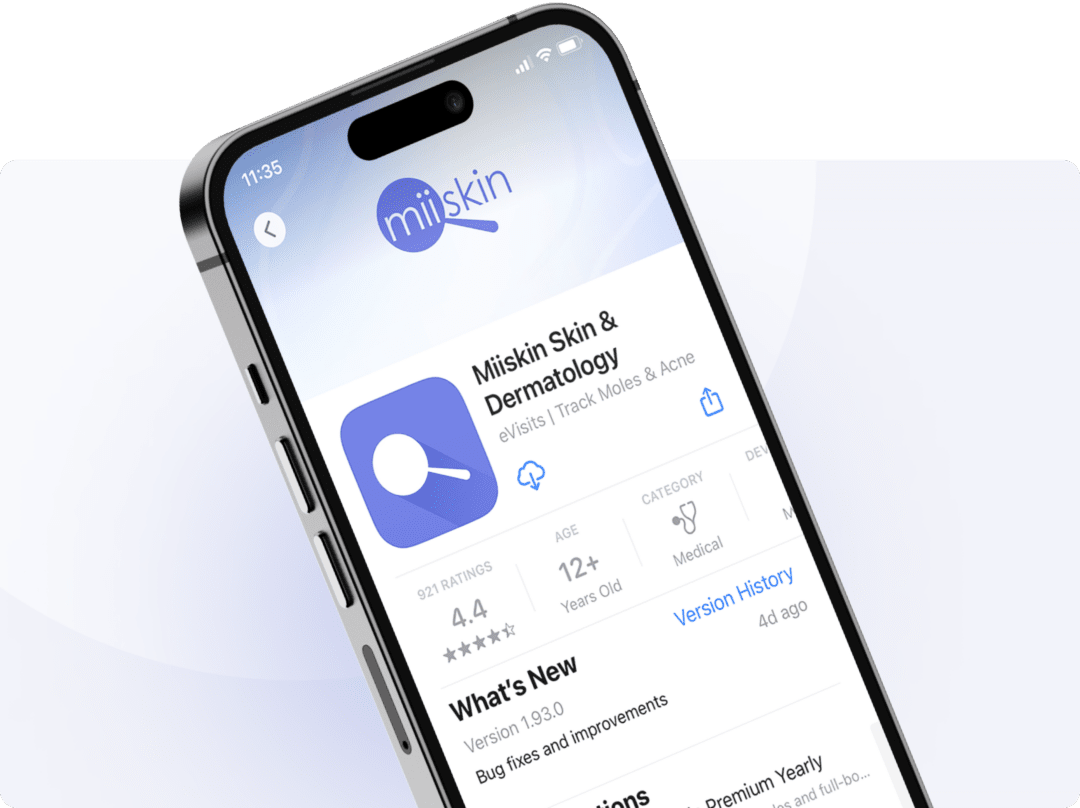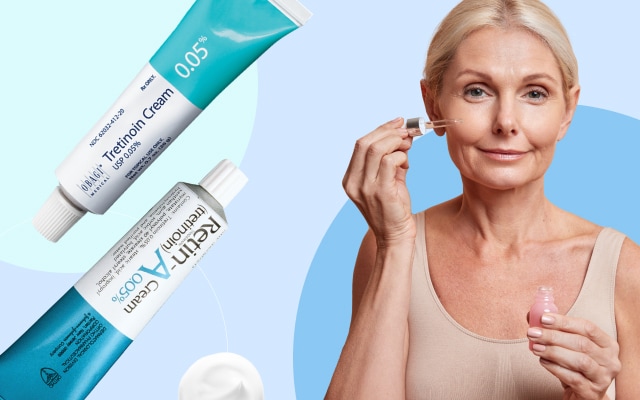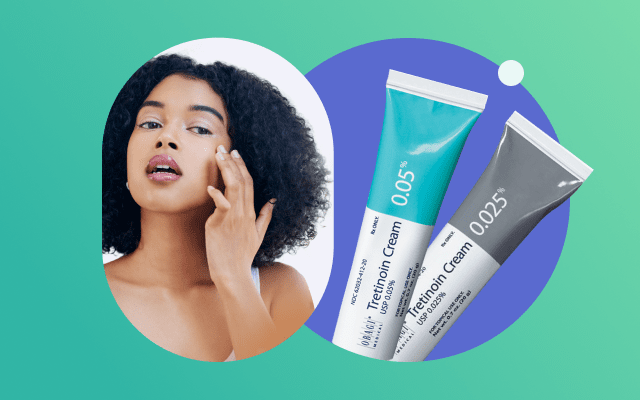Derma rolling: A dermatologist´s guide for patients
Dr. Alpana Mohta discusses the advantages of dermarolling, highlighting its simplicity, cost-effectiveness, and significant benefits for the skin as key factors for its popularity.
Table of Content:
What is derma rolling? | Derma rolling vs micro-needling | What is the purpose? | Does it work? | Benefits | How to use it? | Can you use it with tretinoin and other ingredients? | How often should you use it? | How to clean it? | What type should I use? | How old should I be to use one? | Results
Our commitment to producing high-quality content:
The information presented in this article is based on scientific research and the professional advice of our Content Medical Reviewers, who are experts in the field of Dermatology. How we write our content →
If you have heard about micro-needling or derma-rolling and wondered what that is all about, you have come to the right place!
This dermatologist´s guide on derma rollers by board-certified dermatologist Dr. Alpana Mohta, tells you everything you need to know about derma rolling and answers commonly asked questions users have about these commercial devices widely used for an improved skin appearance.
What is derma rolling?
According to Dr. Mohta, derma-rolling (also known as microneedle rolling or skin needling) involves the use of a handheld device called a derma roller. A derma roller consists of a handle with a drum-shaped roller head covered in tiny needles. Unlike professional micro-needling, derma-rolling can be done at home by individuals. It is a less invasive and less precise method compared to professional micro-needling. Derma-rolling is often used for general improvement in skin texture, although it may also be used for some specific skin concerns like acne scars, stretch marks, and superficial wrinkles.
Ok, but what is micro-needling then?
Micro-needling is a professional medical or cosmetic procedure performed by dermatologists or trained professionals. It typically uses a device with motorized or manual needles to create controlled punctures in the skin. The depth and precision of the needle penetration can be adjusted based on the specific needs of the treatment. Micro-needling is often used for fine lines, wrinkles, acne scars, stretch marks, open pores and skin rejuvenation1.
Are micro-needling and derma rolling the same?
Micro-needling and derma-rolling are similar procedures that involve the use of tiny needles to create controlled micro-injuries in the skin to stimulate collagen production and improve skin texture. However, they differ in terms of the devices used, the depth of penetration, the level of precision, and whether they are performed by professionals or individuals at home.
It is important to note that the effectiveness and safety of these procedures can vary, so it is essential to consult with a dermatologist before deciding which method is suitable for your specific skin concerns.
Consult a Board-Certified Dermatologist Now!

Download the Miiskin app to connect with independent, board-certified dermatologists who are licensed in your state. Answer a few questions, upload some photos and get a treatment plan in 1-2 days. Consultation price is $59 and medication renewals are only $39.
Online dermatology care is ideal for chronic dermatology conditions.
What is a derma roller?
A derma roller (also known as a microneedle roller or skin roller) is a handheld skincare device that is designed to improve the appearance and texture of the skin. It consists of a small, cylindrical roller with a handle, and the roller head is covered with 192 tiny needles arranged in eight rows. These needles are made using reactive ion etching on silicon or high-quality stainless steel. These needles are typically very small, ranging from 0.25 millimeters to 2.5 millimeters in length.
What does a derma roller do?
A derma roller creates controlled micro-injuries over the skin’s surface. These micro-injuries are tiny and superficial, but they stimulate the skin’s natural wound healing response. This process triggers the release of growth factors that encourage the production of fresh collagen and elastin, two proteins responsible for skin elasticity and firmness, in the upper layer of the dermis. It also leads to the formation of new blood vessels that help in reducing scars. Thus, the method is rightly named “percutaneous collagen induction therapy” and is used to treat skin aging and acne scars2.
Does derma rolling work?
In the 90´s medical researchers discovered that needle abrasion played a significant role in scar tissue healing during an experiment involving an empty tattoo gun on surgical scars. Building on this insight, in 2002, a group of scientists developed a technique that involved the controlled disruption of the epidermis using a needle drum. Their study, encompassing nearly 500 patients, had remarkable results, showing a substantial 60 to 80% improvement in collagen and elastin fibers. This breakthrough underscored the potential of derma rollers as a viable alternative to non-invasive therapies, capable of stimulating collagen formation while preserving the overall integrity of the epidermis. Researchers have also discovered that a derma roller effectively enhances the action of various anti-aging topical treatments, such as vitamin C, and retinol by facilitating their deeper delivery into the skin2.
Derma roller benefits
Derma rollers are used for a wide variety of purposes from reducing the appearance of fine lines and wrinkles to stimulating hair growth.
Improve skin texture and tone
Derma rollers with shorter needles (typically 0.25 to 0.5 millimeters) are often used to improve overall skin texture and tone. They can help stimulate collagen production and enhance the skin’s radiance.
Reduce fine lines and wrinkles
Derma rollers with longer needles (0.5 to 1.5 millimeters) can help reduce the appearance of fine lines and wrinkles. By promoting collagen and elastin production, derma rollers can lead to smoother, firmer skin.
Improve the appearance of acne scars
Derma rollers with longer needles are also used to address acne scars. They can help break down scar tissue and encourage the growth of new, healthier skin cells, gradually improving the appearance of acne scars3.
Minimize enlarged pores
Microneedling can help reduce the size of enlarged pores by promoting collagen production and tightening the surrounding skin.
Enhance the absorption of your topical anti-aging skin care products
The effectiveness of cosmetic anti-aging formulations are constrained by their limited ability to penetrate the stratum corneum, as wrinkles develop deep within the dermis. However, derma rollers were introduced to create a pathway for anti-aging formulations to access the target area and deliver their beneficial effects4.
Reduce hyperpigmentation
Derma rollers may be used to address skin discoloration or hyperpigmentation issues, such as melasma or sunspots. Micro-needling can promote a more even skin tone over time.
Reduce the appearance of stretch marks and scars
Derma rollers can be used to improve the appearance of stretch marks by encouraging collagen production and reducing the visible signs of stretch marks and certain types of scars, including surgical scars5.
Stimulate hair growth
Some people use derma rollers with longer needles on the scalp to stimulate hair follicles and promote hair regrowth in cases of thinning hair or alopecia.
How do derma rollers work on the skin?
When healthy skin undergoes derma rolling, it stimulates a healing response stimulating collagen production and effectively breaking down scar tissue.
When derma rollers are used, they create small pores in the dermis, which is a deeper layer of the skin. These pores set off a complex chemical process in the body. Platelets, which are small blood cell fragments, play a crucial role in this process by releasing different substances. This release starts a chain reaction that eventually leads to the release of additional substances called growth factors. These growth factors act as signals that attract fibroblasts, a type of cell, to the treated area. When fibroblasts gather in the area, they become more active and start producing more collagen and elastin, two proteins important for the health and appearance of the skin6.
So, in essence, derma rollers help stimulate the production of collagen and elastin in the skin, which can improve its texture and appearance.
How to use a derma roller?
Here are Dr. Mohta´s instructions on how to use your derma roller:
- Gently wash your face with a mild cleanser to remove makeup, dirt, and oils. Pat your face dry with a clean towel
- Divide your face into sections (forehead, cheeks, chin, etc.) for a more systematic rolling
- Begin with gentle, steady pressure. Roll the derma roller horizontally, vertically, and diagonally in each section
- Avoid rolling too quickly and pressing too hard, as it may cause skin damage
- After completing one direction, change the roller’s direction and repeat the process, ensuring thorough coverage
- Avoid rolling over the same area too many times
- Avoid rolling over the eyes, lips, any active acne breakouts
- Avoid using a derma roller if you have active skin infections, eczema or severe rosacea
- Be extra gentle in areas with thinner skin
- Immediately after rolling, apply a hydrating serum or cream. This helps to nourish and soothe the skin while it’s more receptive to product absorption
- Protect your skin from direct sunlight after derma rolling for the next 3-5 days
- Use sunscreen with SPF 50 while indoors or outdoors.
Is it safe to use the same derma roller more than once?
Ideally, a derma roller should be used only once and then discarded. However, if you plan to use it multiple times, it’s crucial to consult with your dermatologist or aesthetician to learn the best practices for sterilizing your derma roller. To sterilize it at home, you can use a medical-grade disinfectant like 70% isopropyl alcohol.
Can you use topical prescriptions after derma rolling?
Can you use tretinoin after derma rolling?
Dr. Mohta says that after derma rolling, your skin is more sensitive and may be slightly red and irritated. Typically, you should wait 24-48 hours before applying tretinoin.
If you decide to use tretinoin after derma rolling, opt-in for a lower tretinoin strength to minimize excessive irritation and when you decide to use tretinoin after derma rolling, start gradually. Apply a small amount of tretinoin to your skin, and monitor how your skin reacts. If you experience excessive dryness, redness, or irritation, reduce the frequency of application.
When using tretinoin, be sure to use a moisturizer and sunscreen to help counteract dryness and protect your skin from the sun. Read our dermatologist guide on How to use tretinoin.
Can you use glycolic acid after derma rolling?
Dr. Mohta says that you should avoid using glycolic acid on the same day as derma rolling to prevent excessive irritation, allow your skin to recover before introducing glycolic acid which means waiting at least 24-48 hours, before using glycolic acid.
Apply glycolic acid to your skin gently, avoiding any areas that are still red, irritated, or sensitive from derma rolling. After using glycolic acid, apply a hydrating and soothing moisturizer to your skin. This helps to minimize dryness and maintain skin hydration and always use sunscreen during the day.
Start with a lower frequency of glycolic acid use, such as once or twice a week, and gradually increase as your skin tolerates it.
Can you use hydroquinone after derma rolling?
Hydroquinone is routinely used for the management of hyperpigmentation. However, due to its high risk profile, Dr. Mohta advises against the use of hydroquinone after derma rolling.
Can you use azelaic acid after derma rolling?
Azelaic acid is available in different formulations including creams, gels, and serums. Select a product with a low concentration. Before applying azelaic acid to your entire face, consider performing a patch test. Apply a small amount of azelaic acid to a small area of your skin and monitor how your skin reacts. This helps you check for any adverse reactions or excessive irritation.
Can you use hyaluronic acid after derma rolling?
Applying hyaluronic acid after derma rolling is absolutely safe and can be beneficial for your skin. Hyaluronic acid is a hydrating and skin-plumping ingredient that helps improve skin moisture and texture. Select a high-quality hyaluronic acid product from a reputable brand. Look for products that do not contain unnecessary additives or fragrances.
When applying hyaluronic acid, use gentle patting or tapping motions to apply it to your skin. Avoid rubbing or massaging the product aggressively, as your skin may still be sensitive after derma rolling.
After applying hyaluronic acid, it’s a good practice to follow it up with a moisturizer. The moisturizer can help lock in the hydration provided and further soothe the skin.
Can you use niacinamide after derma rolling?
Similar to hyaluronic acid, applying niacinamide after derma rolling is safe and can be beneficial for your skin. Follow the same advice provided for hyaluronic acid.
How often should you use a derma roller?
Dr. Mohta advises you to use your derma roller once a week in the beginning and gradually increase the frequency to two or three times per week. Limit the rolling time to a maximum of 2 minutes during each session.
If you are using a derma roller over 0.5mm in length, don’t use it more than once every week.
After using the derma roller, apply a serum with hyaluronic acid or niacinamide to moisturize. It is very important that your skin has fully recovered before initiating another derma roller session.
How to clean your derma roller?
To clean your derma roller, pour at least east 70% isopropyl alcohol into a glass or container and let it soak for 3-5 minutes, then rinse it thoroughly with cold water and let it air dry for 10 minutes and store it in a clean, dry container until the next use. Cleaning your derma roller after each use is crucial for hygiene and effectiveness. Avoid sharing it with others to prevent contamination and disease spread.
Should I clean my derma roller before using it or after using it?
It is advisable to sanitize your derma roller both before and after each use for the best hygiene practices and to ensure the cleanest and safest application.
- Before use: sanitizing the derma roller before each use helps ensure that it is free from any bacteria or contaminants that may have settled on it between sessions. This initial cleaning step is crucial to prevent introducing harmful microorganisms to your skin during the derma rolling process.
- After Use: sanitizing the derma roller after each use is equally important. It helps remove any residue, blood, or skincare products that may have accumulated on the roller during the rolling session. Cleaning after use maintains the roller’s cleanliness for the next session and prevents the buildup of bacteria or debris.
What type of derma roller should I use?
The most critical factor to consider is the needle length of the derma roller. Different needle lengths are designed for different purposes:
Short needles (0.25mm to 0.5mm) are ideal for improving skin texture and enhancing the absorption of skincare products. They can be used more frequently and are well-suited for beginners.
Medium-length needles (0.5mm to 1.0mm) are effective for addressing concerns like fine lines, mild scarring, and pigmentation issues. They are used less frequently and require more recovery time.
Although you can also purchase derma rollers with long needles (1.0mm and above) Dr. Mohta advises against using these, as they should only be used by trained professionals.
How old should you be to start using a derma roller?
Although there is not a specific age to begin using derma rollers, the production of collagen and elastin typically starts to decline in your early 30s. This may be a good time to introduce derma rolling to your skin care routine.
However, you may also want to wait until your 40’s to introduce this practice as the reduction in the production of collagen and elastin continues and the signs of aging become more apparent. Skin may become thinner, lose volume, and show deeper wrinkles and sagging.
Need Expert Dermatologist Care?

Get expert advice from a licensed online dermatologist by simply uploading photos from your phone. If needed, a prescription (branded or generic depending on preference) will be sent directly to your favorite pharmacy. Nationwide coverage.
How soon will you see results from derma rolling?
The timeline for seeing noticeable results from derma rolling can vary widely depending on several factors, including the specific skin concerns you are addressing, the length of the needles on the derma roller, and your individual skin’s response to the treatment. Usually, it takes 8 weeks before you can expect any visible results.
During the first days or weeks after beginning derma rolling
Immediately after derma rolling, you may experience short-term benefits, such as improved skin texture and a temporary glow due to increased blood flow to the skin. Some people notice a slight reduction in fine lines and improved hydration within the first few weeks of regular derma rolling, especially when using shorter needles (0.25mm to 0.5mm).
During the following weeks to months
Over the course of several weeks to a few months, you may start to see more noticeable improvements, particularly if you are targeting concerns like fine lines, mild scarring, or uneven skin tone. Reduction in the appearance of acne scars or minor wrinkles may become apparent during this phase. Skin may appear smoother, with increased radiance.
After the first year of use
For more deep wrinkles or extensive scarring, it may take several months to a year or more of consistent derma rolling to achieve noticeable improvements. Collagen and elastin production gradually increases, leading to longer-term benefits in skin firmness and elasticity.
Deeper skin concerns may continue to improve with continued derma roller use. To maintain the results and continue improving your skin, regular and consistent derma rolling sessions are often necessary. You may also combine derma rolling with other skincare products and treatments for enhanced results.
Can derma rollers be used on your scalp?
Yes, derma rollers can be used on the scalp for hair growth. Using a derma roller can help stimulate hair follicles, release growth factors and increase blood circulation to the scalp.
Can derma rollers be used on your beard?
Yes, derma rollers for beard can also be used to stimulate the growth of facial hair on areas where the beard does not grow.
References:
https://www.ncbi.nlm.nih.gov/pmc/articles/PMC5556180/
https://www.ncbi.nlm.nih.gov/pmc/articles/PMC2918341/
https://www.ncbi.nlm.nih.gov/pmc/articles/PMC7588378/#CR51
…





 Want a prescription-strength formula for anti-aging?
Want a prescription-strength formula for anti-aging?
